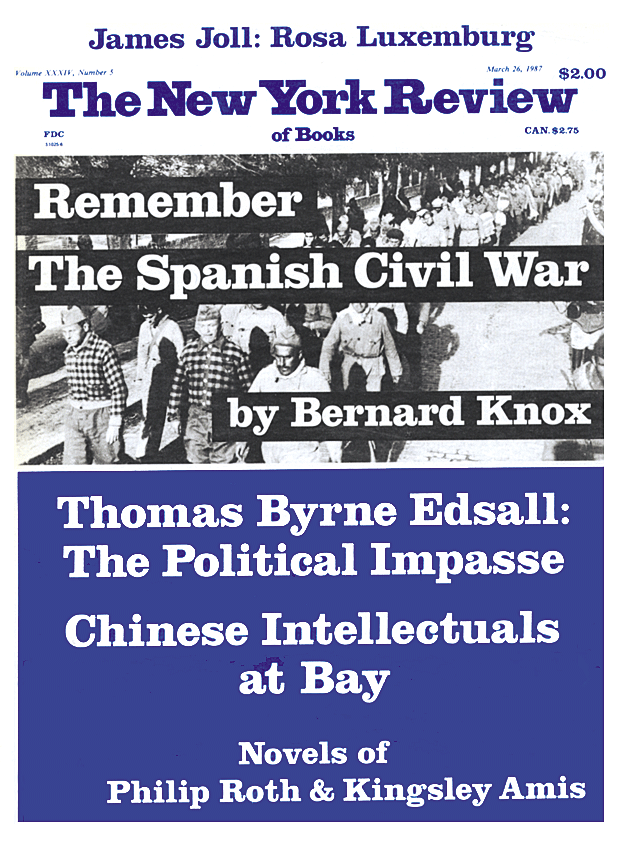In response to:
The Jazz Comeback from the February 12, 1987 issue
To the Editors:
European intellectuals have always cherished their ignorance of the United States, and it is therefore not surprising to see one of them once again trumpeting forth the ancient nonsense that they discovered jazz before the less sensitive and intellectually unsophisticated Americans did [NYR, February 12]. It is, however, a little unnerving to have it come from a social historian, Eric Hobsbawm, who surely should have been trained to investigate a subject before offering his views on it.
The popularity of jazz in the United States was both broad and deep right from the beginning. As early as 1917, when Europeans had barely heard the word, much less the music, American college professors were analyzing it for popular magazines. In the decade of the 1920s The New York Times ran over two hundred articles on jazz, including several fulldress articles in its Sunday Magazine. Leading magazines ran another hundred articles on the subject in the same period. Jazz records were being regularly reviewed at various times and places; it will no doubt startle Professor Hobsbawm to be told that early classics by Armstrong, Ellington and others were receiving excellent reviews when they appeared in America. Several writers, among them R.D. Darrell, Abbe Niles, Carl Van Vechten, and John Hammond were producing, by the end of the decade, first-rate jazz criticism, which would not be matched in quantity or quality for almost a decade in Europe. The press would hardly have given jazz this attention had Americans been uninterested in it, or actively hostile to it.
Europeans first began to understand what jazz was really all about in the fall of 1929, when some editors from the British paper, the Melody Maker, came to New York expressly to study the music. They were taken to Harlem by some insensitive Americans, and were left standing with their mouths open, as their own report on the experience makes clear. At the very moment when Europeans were finally being introduced to real jazz, Duke Ellington was the house band leader at the Cotton Club, America’s most famous cabaret; Fletcher Henderson was the house band leader at Roseland Ball Room, the country’s most famous dance hall; Louis Armstrong and Fats Waller were in a hit show on Broadway, and were doubling at Connie’s Inn, another famous nightclub; King Oliver was working at the fancy Quogue Inn on Long Island; Earl Hines was taking a new band into an important Chicago nightclub, the Grand Terrace; Bix Beiderbecke was the principal soloist with the country’s most famous dance band, Paul Whiteman’s. Significantly, all of these groups were broadcasting regularly, in some cases nightly, on a nationwide basis over the newly formed broadcasting networks.
These great jazz musicians were playing for a mainstream, white American audience that cut across all classes and all ethnic groups, and they were giving them precisely the music that Europeans, several years later, would begin to congratulate themselves for discovering.
James Lincoln Collier
New York City
E.J Hobsbawm replies:
James Lincoln Collier has written the best history of jazz I know. I do not think I wrote anything that differs in substance from his own opinion that there is some substance in the view “that Europeans have generally been more receptive to jazz than Americans…. Europeans wrote about jazz earlier than Americans did, and they have often written about it better since.” (J.L. Collier, The Making of Jazz: A Comprehensive History, Houghton Mifflin, 1978, p. 313.) I did not say or imply that Americans were uninterested in jazz or actively hostile to it, but that the idiom was so much part of their lives that it was difficult for them to treat it “as an art form” (The Making of Jazz), and that it did not fit into American ideas about high culture in the early period. If it did, I have not heard of it. That does not mean that it was not extensively written about in the American press, or extensively reviewed. There was immeasurably more of it in New York than in Europe, and still is. And there were people like my old and admired friend John Hammond who were in a far better position to review it knowledgeably than anyone in Europe.
This Issue
March 26, 1987


